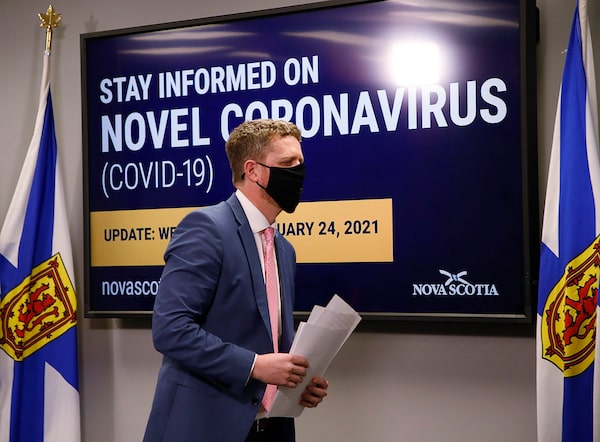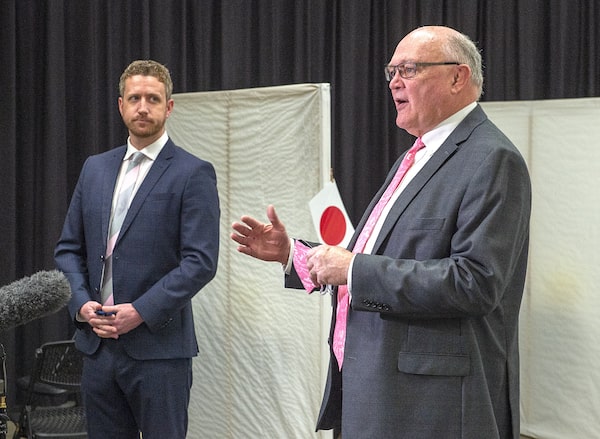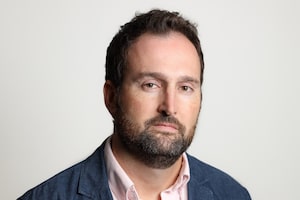
Nova Scotia Premier Iain Rankin departs from a COVID-19 news conference in Halifax on Feb. 24, 2021.Tim Krochak/The Canadian Press
Long lines are forming at COVID-19 test sites around Nova Scotia as the province, one of Canada’s success stories in the fight against the coronavirus, tries to stamp out a sudden surge in cases and keep the pandemic’s third wave at bay.
Nova Scotia, with 181 new cases in the past three days, is shutting down schools and social gatherings in response to spiking COVID-19 numbers that are outstripping the previous peak a year ago, when the virus was first detected in the province. Sixty-six of those cases were confirmed Monday, another daily record.
Canada vaccine tracker: How many COVID-19 doses have been administered so far?
Am I eligible for a COVID-19 vaccine? The latest rules by province
While its 323 active cases are still a small fraction of those in Alberta, Saskatchewan, Ontario and British Columbia, the province is not waiting to act. It’s following a tried-and-true model used by the Atlantic provinces throughout the pandemic to respond aggressively to early outbreaks, allowing the region to keep more businesses and schools open in the long run.
Schools in the Halifax region have moved to online learning, and all field trips and activities that bring students from different schools together have been cancelled. Strict operating limits have been imposed on salons, gyms, arenas and businesses outside Halifax, while restaurants and bars inside the capital region are now closed for in-person dining. Nova Scotians are being asked not to leave their communities unless absolutely necessary, while in Halifax, the gathering limit has been reduced to five people. Fines have been doubled to $2,000 for those caught breaking the Health Protection Act.
Premier Iain Rankin said his province is at a “very serious crossroads” and urged Nova Scotians to stay home. He began Monday’s COVID-19 update by speaking directly to those driving the rising case counts – young people – after an infected person in their 20s was placed in a Halifax intensive care unit.
“This is a wake-up call to our younger people,” Mr. Rankin said. “You are not invincible and you need to take this virus seriously.”
The Atlantic provinces are anxiously watching the third wave roll across much of Canada, and are tightening entrance restrictions in an effort to keep it out. On the weekend, New Brunswick became the first province in Canada to require most domestic travellers to self-isolate for at least seven days in a designated hotel at their own expense. Previously, they could quarantine at a private residence.
Prince Edward Island, with just 11 active cases, is now requiring anyone who has been in Nova Scotia to get tested twice upon returning to the island – including truck drivers and rotational workers who were previously exempt.
Even as restrictions are ramped up, some are calling for Nova Scotia to do more. The province is not using rapid tests at airports, something the Halifax Stanfield International Airport has been asking for since January. The Charlottetown airport introduced the measure in February.
Tim Houston, Nova Scotia’s Progressive Conservative Leader, said rapid testing at airports must become mandatory, and called on the Premier to expand testing capacity for rural areas as well. Many of the cases in the province have been related to travel from other parts of Canada, although community spread is now happening.
“The health and safety of Nova Scotians must come first,” Mr. Houston said. “Nova Scotians are experiencing high levels of anxiety with the uncertainty and confusion of each passing day. It’s time for the government to step up and show that it has a real plan.”
So far, the only testing at the Halifax airport is for temporary foreign workers arriving on specially authorized charter flights directly from international locations. The airport says it’s been “advocating for testing” for several months and in January submitted a detailed proposal to the provincial government for how those rapid tests could work.
“We remain in discussions with provincial officials about setting up testing for both airport workers and passengers, but we don’t have a firm timeline on when this may occur and what type of testing would be used,” said Tiffany Chase, director of public affairs for the airport.

Dr. Robert Strang, Nova Scotia chief medical officer of health, right, and Premier Iain Rankin field questions after a tour of a COVID-19 vaccination clinic in Halifax on April 16, 2021.Andrew Vaughan/The Canadian Press
Dr. Robert Strang, the province’s Chief Medical Officer, said plans to introduce rapid testing at the airport have been delayed by the surge in demand for testing in the larger community. But he insisted 14-day self-isolation requirements at a location of the traveller’s choice is more effective than testing people when they first arrive.
“The most important thing that controls the entrance of virus into the province is quarantining, not testing,” he said. “Virtually all travellers who are coming in are being tested, they just may not be tested at the airport.”
At least 30 recent cases in Nova Scotia are connected to schools, which is why thousands of students and teachers across the province have been sent home for two weeks. Another cluster in Cape Breton has been traced to several youth hockey games at the Membertou Sport & Wellness Centre outside Sydney, N.S.
The Atlantic provinces have used some of the toughest public-health measures in the country to respond to outbreaks quickly and keep cases numbers low. When an outbreak struck Newfoundland and Labrador in February, delaying the provincial election, officials locked down the capital region and got control of case numbers within a few weeks. There are now just 25 active cases in the province.
While residents may complain about restrictions that have kept families apart and hurt the tourism industry, the results have been hard to argue with. Hospitals here have not seen mass influxes of sick people, and a mandatory two-week self-isolation requirement for all visitors is credited with catching many cases before they can spread.
Manitoba, meanwhile, has seen its COVID-19 cases climb steadily this month after beating back the second wave. That province’s active cases stand at 2,093, significantly higher than Nova Scotia, but officials there have held off on imposing the kind of restrictions now in place in the Halifax region.
While both provinces have moved to limit gatherings, people in Winnipeg can still dine in restaurants, go to school and watch youth sporting events – three things that have been shut down in Nova Scotia’s capital.
Our Morning Update and Evening Update newsletters are written by Globe editors, giving you a concise summary of the day’s most important headlines. Sign up today.
 Greg Mercer
Greg Mercer